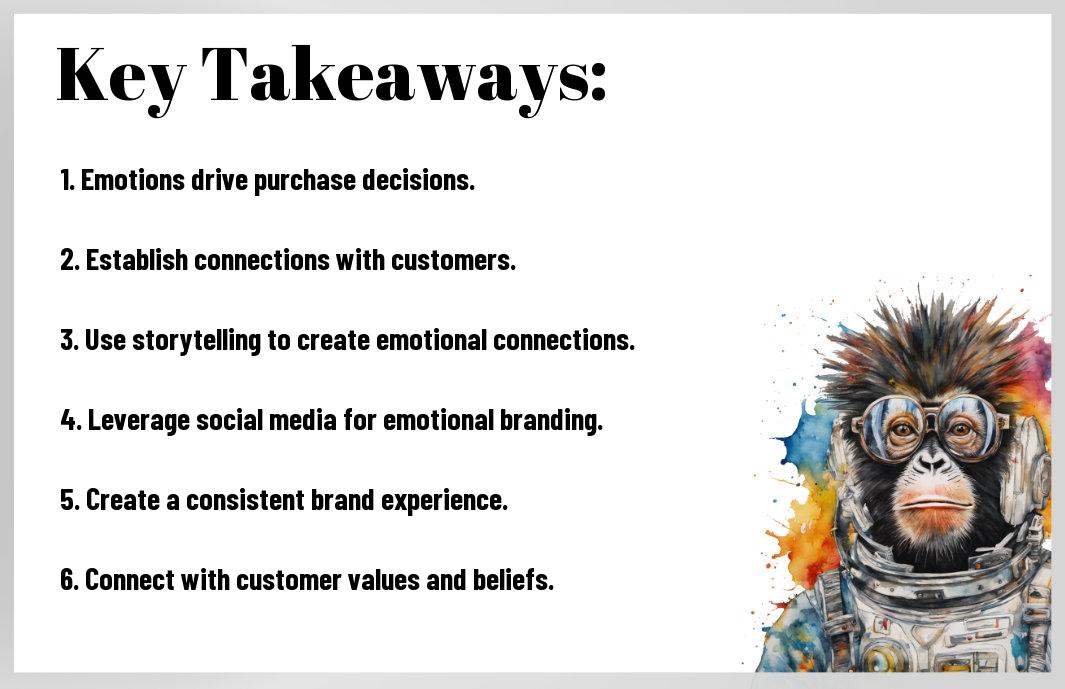The Power Of Emotional Branding In Dropshipping Marketing
#Branding is crucial in dropshipping marketing as it sets a business apart from competitors and creates a loyal customer base. Emotional branding takes this a step further by tapping into customers’ feelings, creating a lasting connection. Incorporating emotional triggers such as trust, belonging, and aspiration can significantly impact purchase decisions and brand loyalty. However, overlooking the importance of emotional branding can be dangerous for dropshipping businesses, as they risk appearing generic and forgettable in a saturated market. By harnessing the power of emotional branding, dropshipping businesses can elevate their marketing strategies and build a strong, recognizable brand that resonates with their target audience.
Key Takeaways:
- Emotions drive purchasing decisions: Emotional connection with a brand can lead to increased sales and customer loyalty in dropshipping marketing.
- Storytelling is powerful: Sharing a brand story that evokes emotions can resonate with customers and create a strong bond with the brand.
- Use social proof: Showcasing positive customer reviews and testimonials can create trust and emotional connection with potential customers.
- Create a sense of belonging: Build a community around your brand to make customers feel like they are a part of something bigger, creating emotional loyalty.
- Personalization is key: Tailoring marketing messages and products to individual preferences can create a more emotional connection with customers.
- Utilize visuals effectively: High-quality images and videos that evoke emotions can help customers connect with your brand on a deeper level.
- Consistency is crucial: Maintaining a consistent brand voice and messaging across all platforms can help reinforce the emotional connection with customers over time.

Emotional Branding Defined
Emotional branding is a marketing strategy that focuses on creating a deep emotional connection between a brand and its customers. Rather than just selling products or services, emotional branding aims to evoke specific feelings, associations, and memories that resonate with consumers on a personal level.
Principles of Emotional Branding
For successful emotional branding, it is crucial to understand the core principles that guide this strategy. This includes authenticity, storytelling, consistency, customer experience, and community building. By embodying these principles, brands can establish a strong emotional bond with their customers, leading to loyalty and advocacy.
The Psychology Behind Consumer Decisions
Behind every consumer decision lies a complex interplay of psychological factors. Emotions, beliefs, experiences, and cognitive biases all play a role in shaping how individuals perceive and interact with brands. Understanding the psychology behind consumer decisions can help marketers create targeted campaigns that resonate with their target audience on a deeper level.
A key aspect of the psychology behind consumer decisions is the concept of emotional triggers. These are specific cues or stimuli that prompt an emotional response in individuals, influencing their purchasing behavior. By leveraging emotional triggers effectively, brands can create memorable and impactful marketing campaigns that drive customer engagement and brand loyalty.

Strategies for Implementing Emotional Branding in Dropshipping
Storytelling and Brand Identity
All successful brands have a compelling story that resonates with their target audience. Storytelling in dropshipping marketing is crucial for creating an emotional connection with customers. By sharing the journey of your brand, the values it upholds, and the impact it seeks to make, you can build brand identity that inspires loyalty and trust. Any dropshipping business looking to implement emotional branding should focus on crafting a narrative that reflects the essence of their brand and speaks directly to the desires and aspirations of their target market.
Leveraging Customer Emotions through Visuals and Copy
An effective way to tap into customer emotions is through the strategic use of visuals and copy in marketing materials. Visuals can convey powerful emotions and create a strong impact on viewers, while compelling copy can evoke desire, trust, and excitement. Customer emotions play a significant role in influencing purchasing decisions, so it’s necessary to design marketing campaigns that elicit the desired emotional responses from your target audience. Utilize high-quality images, persuasive language, and storytelling elements to engage customers emotionally and drive conversions.
Challenges and Solutions for Emotional Branding in Dropshipping
Differentiation in a Saturated Market
Onymous in a saturated dropshipping market, standing out can be a daunting task. With numerous competitors offering similar products at competitive prices, it can be challenging to establish a unique brand identity that resonates with customers. One solution to this challenge is to focus on creating a strong emotional connection with your target audience. By understanding their needs, values, and desires, you can tailor your brand messaging and marketing efforts to differentiate yourself from the competition.
Building Trust with No Physical Presence
With the absence of a physical storefront, building trust in dropshipping can be a hurdle for many brands. Customers may be hesitant to purchase from a brand they have never interacted with in person. To overcome this challenge, it is vital to prioritize transparency and reliability in all your interactions. Provide detailed product descriptions, clear shipping information, and responsive customer service to instill confidence in your customers. Utilize customer reviews and testimonials to demonstrate the positive experiences of past buyers, further reinforcing trust in your brand.
Measuring the Impact of Emotional Branding
Key Performance Indicators (KPIs)
Keep a close eye on Key Performance Indicators (KPIs) to measure the impact of emotional branding in your dropshipping marketing strategy. KPIs such as website traffic, conversion rates, customer engagement, and social media interactions can provide valuable insights into how your emotional branding efforts are resonating with your audience.
Customer Feedback and Brand Loyalty Metrics
With the rise of social media and online reviews, customer feedback plays a crucial role in gauging the success of your emotional branding initiatives. Monitoring brand sentiment, customer satisfaction scores, and brand loyalty metrics can help you understand how customers perceive your brand on an emotional level.
Emotional connections with customers lead to stronger brand loyalty and higher customer lifetime value. By tracking customer feedback and brand loyalty metrics, you can identify areas for improvement and continuously refine your emotional branding strategy to build long-lasting relationships with your audience.
Another crucial aspect to consider is the impact of customer testimonials and word-of-mouth referrals on brand loyalty. Encouraging satisfied customers to share their positive experiences can further strengthen emotional connections and foster a community of loyal brand advocates.
To wrap up
Upon reflecting on the power of emotional branding in dropshipping marketing, it is evident that creating a strong emotional connection with customers is crucial for building brand loyalty and driving sales. By understanding and tapping into the emotions of your target audience, you can differentiate your brand, foster trust, and create memorable experiences that keep customers coming back for more. Leveraging emotional branding in your dropshipping marketing strategy can set you apart in a competitive market and help you establish a long-lasting and successful business. Note, emotions drive purchasing decisions, so connecting with your customers on an emotional level can be the key to standing out and thriving in the world of dropshipping.
FAQ
Q: What is emotional branding in dropshipping marketing?
A: Emotional branding in dropshipping marketing is the strategy of connecting with your customers on an emotional level to build brand loyalty and drive sales. It involves creating a strong emotional bond between your brand and your target audience.
Q: Why is emotional branding important in dropshipping marketing?
A: Emotional branding is important in dropshipping marketing because it helps you stand out from the competition, create a memorable brand experience, and foster long-term relationships with your customers. It also increases customer loyalty and can lead to higher conversion rates.
Q: How can emotional branding be implemented in dropshipping marketing?
A: Emotional branding can be implemented in dropshipping marketing through storytelling, creating a strong brand identity, using emotional triggers in your marketing campaigns, and focusing on customer experience and satisfaction.
Q: What are the benefits of using emotional branding in dropshipping marketing?
A: The benefits of using emotional branding in dropshipping marketing include increased brand loyalty, higher customer engagement, improved brand recognition, and the ability to charge premium prices for your products or services.
Q: How can I identify the emotions I want to evoke in my dropshipping marketing efforts?
A: You can identify the emotions you want to evoke in your dropshipping marketing efforts by understanding your target audience, conducting market research, and analyzing your brand values and mission. It’s important to align the emotions you want to evoke with your brand identity and the needs of your customers.
Q: What are some examples of successful emotional branding in dropshipping marketing?
A: Some examples of successful emotional branding in dropshipping marketing include brands that create heartwarming storytelling campaigns, use nostalgia to evoke emotions, or focus on social causes that resonate with their target audience. Brands like Nike, Coca-Cola, and Apple are known for their effective use of emotional branding.
Q: How can I measure the success of my emotional branding efforts in dropshipping marketing?
A: You can measure the success of your emotional branding efforts in dropshipping marketing by tracking metrics such as customer loyalty, brand awareness, customer engagement, conversion rates, and customer satisfaction. It’s also important to collect feedback from customers to understand how they perceive your brand emotionally.







